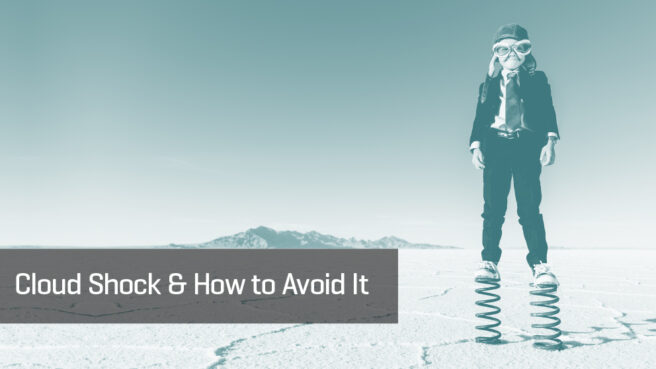Cloud Shock & how to avoid it

As many organizations rush to fund digital transformation projects, so newly-empowered technology decision makers from across the organization are investing in cloud-based technologies, primarily infrastructure (IaaS) and software (SaaS).
Easy to set-up, cheaper running costs, paid for out of operating expenses and with little or no dependencies on the traditional IT infrastructure, cloud-based services have a lot going for them.
And many budget holders (whether in IT or other parts of the business) are going all-in on cloud, giving their teams free rein to spin up cloud services in the hopes of bringing new products and services to market, or achieving competitive advantage.
No wonder then that different analyst firms are predicting growth rates of up to 100% for SaaS spend and as much as 200% on IaaS in the next three years.
All sounds good.
Or maybe not.
While most of the above statements about the benefits of moving apps, services and workloads to the cloud are true, many organizations are starting to experience a major downside to this unfettered access to cloud technologies: a phenomenon known as Cloud Shock.
In simple terms, Cloud Shock is the moment when a budget holder (or worse, the CFO) realizes that their actual spending on cloud is out of control and much higher than was forecasted. It’s an increasingly-common story as organizations suffer the consequences of under-budgeted and under-governed cloud spend.
Cloud Shock is real
At recent SnowStorm user events in London, Sydney and Auckland, I asked attendees whether they recognized Cloud Shock and had seen it in their own organization. Almost unanimously, the answer was yes.
Although there’s no definitive timescale for the onset of Cloud Shock – it could be as quickly as a single quarter, or as long as a couple of years – almost all the SAM and IT professionals I spoke to (even those in cloud-averse industries like finance and healthcare) at the events said they had seen the same thing: either the lines of business managers or the CFO had come to them when they realized that actual cloud spending was significantly higher than they had expected.
The irony was not lost on them that, while the technology spending power is more dispersed than ever, it was still the IT and SAM functions that were called on to provide the answer when budget holders couldn’t reconcile their cloud bills.
How to avoid Cloud Shock
Avoiding (or addressing) Cloud Shock relies on knowing what cloud technologies and services are being consumed across the organization, regardless of who set them up or is paying for them. What we perhaps previously called Shadow or Ghost IT is now just business as usual for many organizations. This is creating a visibility issue not only for central IT teams but also for individual business units who are increasingly ‘spending in the blind’.
Fortunately, organizations that use the Snow platform are in a better position to be able to avoid or address Cloud Shock by providing technology decision makers with the ability to:
- Govern the process of creating IaaS instances – automatically creating approved instances in the right environment with the appropriate attributes and cost centers, automatically retiring the instance after a pre-determined time or period of inactivity to eliminate wasted spend.
- Identify the use of SaaS applications across the organization – pinpointing the use of SaaS applications is the first step to understanding the costs associated with cloud computing, especially when subscriptions are created with no involvement from the centralized IT function.
- Pull subscription data from leading SaaS applications – to manage costs, organizations need to understand what subscriptions have been provisioned, to whom and at what level. Effective subscription management for SaaS apps can yield significant cost recoveries.
It’s not all about reducing costs
While most organizations accept that the need to fund digital transformation initiatives will require more money to be invested in technology, few can afford to over-pay for cloud services that do not drive business value.
By monitoring and managing all forms of cloud spend, the asset management function can deliver new values to CFOs and lines of business managers, helping to avoid Cloud Shock and giving decision makers the confidence that they are investing wisely and making the most of their subscribed services.
To learn more about how the Snow platform can help you avoid Cloud Shock, speak to a specialist today.
Gartner, “Magic Quadrant for Software Asset Management Tools, 16 April 2018, Roger Williams | April Adams | Matt Corsi”
“Gartner does not endorse any vendor, product or service depicted in its research publications, and does not advise technology users to select only those vendors with the highest ratings or other designation. Gartner research publications consist of the opinions of Gartner’s research organization and should not be construed as statements of fact. Gartner disclaims all warranties, expressed or implied, with respect to this research, including any warranties of merchantability or fitness for a particular purpose.”